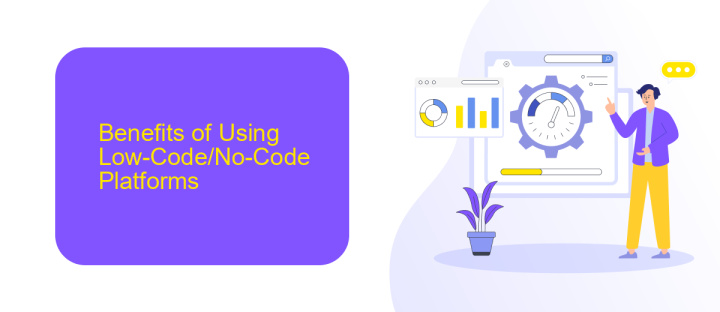Benefits of Low-Code No-Code Platforms
In today's fast-paced digital landscape, businesses are increasingly turning to low-code and no-code platforms to accelerate innovation and streamline operations. These platforms empower users with little to no programming experience to create sophisticated applications, reducing development time and costs. This article explores the numerous benefits of adopting low-code and no-code solutions, from enhanced agility to improved collaboration across teams.
Introduction to Low-Code/No-Code Platforms
Low-code and no-code platforms are revolutionizing the way businesses develop software by enabling users to create applications with minimal or no coding experience. These platforms provide visual development environments where users can drag and drop components to build applications quickly and efficiently.
- Accelerated development processes
- Reduced costs and resource requirements
- Enhanced collaboration between technical and non-technical teams
- Greater flexibility and scalability
One of the key advantages of low-code/no-code platforms is their ability to facilitate seamless integrations with various services and applications. For instance, ApiX-Drive allows users to automate workflows by connecting different applications without the need for complex coding. By leveraging such tools, businesses can streamline their operations and improve overall productivity.
Benefits of Using Low-Code/No-Code Platforms

Low-code and no-code platforms offer significant benefits, making them an attractive option for businesses of all sizes. These platforms allow users to create applications with minimal coding knowledge, reducing the dependency on highly skilled developers. This democratization of app development accelerates the development process, enabling faster time-to-market for new solutions. Additionally, these platforms often come with pre-built templates and drag-and-drop interfaces, simplifying the creation of complex applications and reducing the likelihood of errors.
Another key advantage of low-code and no-code platforms is their ability to integrate seamlessly with existing systems and third-party services. Tools like ApiX-Drive facilitate these integrations, allowing businesses to connect various applications without extensive coding. This capability enhances operational efficiency by automating workflows and ensuring data consistency across different platforms. Moreover, the cost savings associated with reduced development time and lower dependency on specialized developers make these platforms a cost-effective solution for modern businesses looking to innovate quickly and efficiently.
Examples of Low-Code/No-Code Platforms

Low-code and no-code platforms are revolutionizing the way businesses develop applications by simplifying the development process. These platforms empower users with minimal coding skills to create functional applications efficiently.
- Microsoft Power Apps: This platform allows users to build custom apps with a simple drag-and-drop interface, integrating seamlessly with other Microsoft services.
- OutSystems: Known for its robust capabilities, OutSystems provides a comprehensive suite for developing and deploying applications quickly.
- ApiX-Drive: Specializing in integrations, ApiX-Drive enables users to connect multiple applications and automate workflows without extensive coding knowledge.
- AppSheet: Acquired by Google, AppSheet empowers users to create mobile and web apps directly from data sources like Google Sheets and Excel.
- Bubble: Bubble offers a visual programming language that allows users to build fully functional web applications without writing code.
These platforms are transforming the software development landscape by making it accessible to a broader audience. Tools like ApiX-Drive are particularly valuable for automating integrations and streamlining business processes, thus enhancing overall efficiency.
Challenges of Using Low-Code/No-Code Platforms

While low-code and no-code platforms offer numerous benefits, they are not without their challenges. One significant issue is the potential for limited customization. These platforms often provide pre-built modules that may not cover all specific business needs, leading to constraints in functionality and design.
Another challenge is the dependency on platform vendors. Businesses may find themselves locked into a specific vendor's ecosystem, which can be problematic if the vendor changes their pricing model, discontinues support, or fails to update the platform to meet evolving technological standards.
- Limited customization options
- Vendor lock-in
- Scalability issues
- Security concerns
Integrating low-code/no-code platforms with existing systems can also be complex. However, services like ApiX-Drive can help streamline this process by automating data transfer and synchronizing various applications. Despite these challenges, careful planning and the use of supplementary tools can mitigate many of these issues, making low-code/no-code platforms a viable solution for many organizations.


Conclusion
In conclusion, low-code no-code platforms offer a transformative approach to software development, enabling businesses to accelerate their digital transformation efforts. These platforms empower non-technical users to create and deploy applications with minimal coding knowledge, thereby reducing development time and costs. By democratizing the development process, organizations can foster innovation and agility, responding more swiftly to market demands and customer needs.
Moreover, the integration capabilities of low-code no-code platforms are a significant advantage. Services like ApiX-Drive facilitate seamless integration with various applications and systems, streamlining workflows and enhancing productivity. By leveraging such tools, businesses can ensure that their applications are not only quickly developed but also effectively connected with their existing technology stack. This holistic approach to development and integration ultimately drives operational efficiency and business growth.
FAQ
What are Low-Code No-Code platforms?
What are the key benefits of using Low-Code No-Code platforms?
How do Low-Code No-Code platforms help with automation and integration?
Are Low-Code No-Code platforms secure?
Can Low-Code No-Code platforms scale with my business?
Do you want to achieve your goals in business, career and life faster and better? Do it with ApiX-Drive – a tool that will remove a significant part of the routine from workflows and free up additional time to achieve your goals. Test the capabilities of Apix-Drive for free – see for yourself the effectiveness of the tool.

